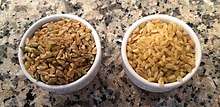Freekeh
Freekeh (sometimes spelled frikeh) or farik (Arabic: فريكة / ALA-LC: farīkah) (pronounced free-kah /ˈfɹiːkə/) is a cereal food made from green durum wheat (Triticum turgidum var. durum) that is roasted and rubbed to create its flavour. It is an ancient dish derived from Levantine and North African cuisines,[1][2] remaining popular in many countries of the eastern Mediterranean Basin where durum wheat originated.[3]
 | |
| Course | Main |
|---|---|
| Place of origin | Levant |
| Main ingredients | Green durum wheat |
The wheat is harvested while the grains are green and the seeds are still soft; it is then piled and sun-dried. The piles are carefully set on fire so only the straw and chaff burn. Under these conditions, the high moisture content of the seeds prevents them from burning. The roasted wheat is then threshed and sun-dried to achieve a uniform flavour, texture and colour. This threshing or rubbing process of the grains gives this food its name, farīk or “rubbed”. Finally, the seeds are cracked into smaller pieces that resemble green bulgur.[1]
History
Freekeh is mentioned in an early thirteenth-century Baghdad cook book as farīkiyya.[1] In that recipe, meat is fried in oil and braised with water, salt, and cinnamon bark. Then, dried coriander is stirred in with young wheat ("freekeh") and is cooked. Finally, the meal is served with cumin, cinnamon, and fresh lamb tail fat.[1]
Culinary

In Egypt, freekeh is served as ḥamām bi’l-ferīk (pigeon stuffed with green wheat). Freekeh also is prepared in Egypt with onion and tomato, and sometimes, with chicken. Shūrbat farīk bi’l-mukh is a freekeh and bone marrow soup from Tunisia. Freeket lahma, a green wheat pilaf dish with roasted lamb, spring peas, and pine nuts, comes from Jordan, and shūrba al-farīk is a Palestinian soup with green wheat and chicken.[1]
In Syria, freekeh usually is prepared with lamb, onion, butter, almonds, black pepper, cinnamon, cumin, and salt.
In Tunisia and Algeria, freekeh is usually prepared as a main ingredient in a tomato-based soup called "chorba't frik", which is considered a traditional national dish.
In Turkey, where this food is known as firik, a pilaf dish based on freekeh, called firik pilavı, is found in traditional Southern Anatolian cuisine. It may be combined with bulgur; legumes such as chickpeas and various herbs and spices, and sometimes meat, may be added. With the influx since 2011 of millions of Syrian refugees, firik is available in markets all over Turkey.
Nutritional value
| Nutritional value per 100 g (3.5 oz) | |
|---|---|
| Energy | 1,418 kJ (339 kcal) |
71 g | |
2.5 g | |
14 g | |
| Vitamins | Quantity %DV† |
| Thiamine (B1) | 37% 0.42 mg |
| Riboflavin (B2) | 10% 0.12 mg |
| Niacin (B3) | 45% 6.7 mg |
| Pantothenic acid (B5) | 19% 0.94 mg |
| Vitamin B6 | 32% 0.42 mg |
| Folate (B9) | 11% 43 μg |
| Minerals | Quantity %DV† |
| Calcium | 3% 34 mg |
| Iron | 27% 3.5 mg |
| Magnesium | 41% 144 mg |
| Manganese | 143% 3.0 mg |
| Phosphorus | 73% 508 mg |
| Potassium | 9% 431 mg |
| Sodium | 0% 2 mg |
| Zinc | 44% 4.2 mg |
| Other constituents | Quantity |
| selenium | 89 ug |
| water | 11 g |
| |
| †Percentages are roughly approximated using US recommendations for adults. | |
Freekeh's nutritional attributes are comparable to other cereal grains, especially durum wheat, from which it is derived, depending on the durum cultivar.[1][4] Durum is notable for its high content of protein (20% or more of the Daily Value, DV), dietary fiber, B vitamins, and several dietary minerals, especially manganese (143% DV) (table). Before roasting, freekeh is 11% water, 71% carbohydrates, 2.5% fat, and 14% protein.
See also
- Grünkern, a similar preparation made from spelt
- List of African dishes
References
- Freekeh - Farik - Green Wheat Clifford A. Wright.
- Anissa Helou, "Freekeh", in Alan Davidson, ed., The Oxford Companion to Food
- Jenkins JA (1966). "The origin of cultivated wheat". Can J Genet Cytol. 8: 220–32.
- Velland E (14 July 2015). "Grilled Halloumi and Freekeh Salad". The Globe and Mail, Food and Wine, Toronto.